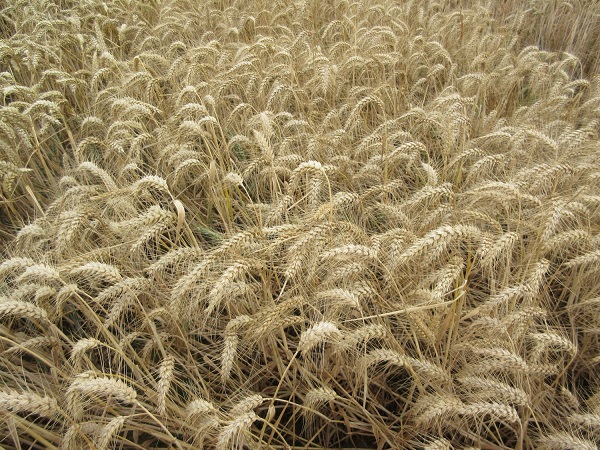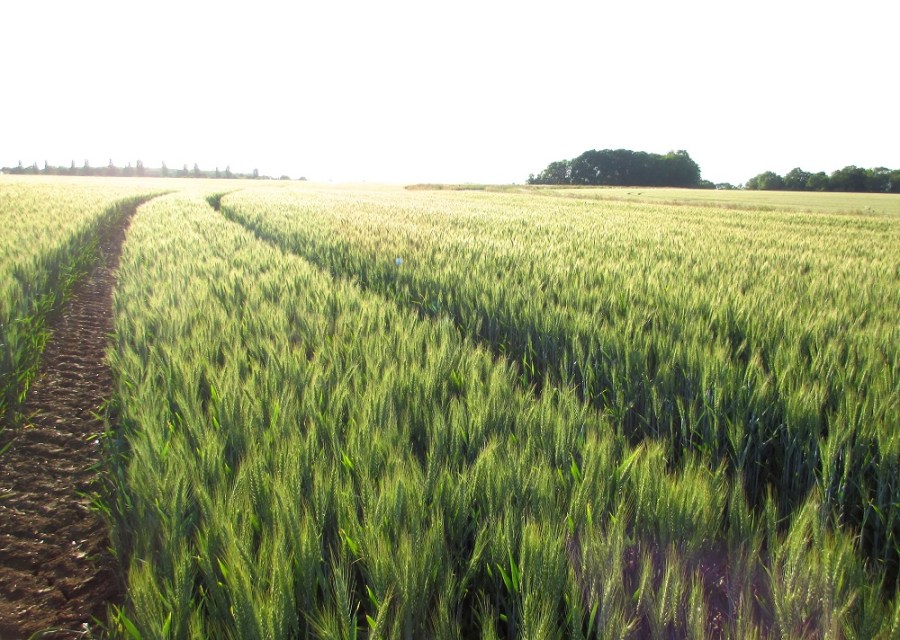Quite a different wheat variety has appeared, with very high quality characteristics, particular requirements for its growers and an unusual approach to seed royalties. CPM reports.
Breeders have dumbed down wheat, so it’s time to change all that.
By Tom Allen-Stevens
There’s a new winter wheat going into commercial production this year that could put an interesting complexion on the seed market.
Mv Fredericia is Soissons-early to mature, with high bread-making quality – similar to German E-grade protein quality. It competes fiercely against blackgrass, holds its own against septoria and is suitable for late drilling after sugar beet or potatoes. It comes from Hungary and is the first variety from an independent British breeder, but you won’t ever find it on the AHDB Recommended List, because it hasn’t been entered as a candidate. Its royalty payment will be deliberately low and will vary with the wheat price, and US$5 of every tonne of seed sold will go to the Borlaug Training Foundation.

Fredericia is Soissons-early to mature, with a German E-grade protein quality.
It’s fair to say there’s not a wheat like it on the seed market, neither in its characteristics nor in the way it’ll be made available to growers. It’s been carefully selected for the UK market by British breeder Bill Angus, who’s also marketing the variety through Angus Wheat Consultants, the company he owns with his wife, Judy.
“A lot of varieties available in the UK at the moment are very incestuous,” he says. “Breeders have dumbed down wheat, so it’s time to change all that.”
Bill was schooled in wheat breeding at PBI (Cambridge) by the legendary John Bingham, who developed the semi dwarf wheats in the UK which transformed the way wheats are grown. Having spent many years as senior breeder at Limagrain, responsible for wheat varieties such as Claire and Crusoe, Bill set up F1 Seeds, primarily for developing new genetics for Bayer’s hybrid wheat programme.
“When you’re working with such a diverse range of varieties, inevitably you come across some interesting inbred lines,” he explains. And Mv Fredericia is the first to appear from this programme.
But why Hungary? “If you go fishing, you have to know what pond to put your rod in,” says Bill. “I wanted something different from the current UK lines, and the Hungarian Academy of Science (Martonvasar) has some of the best breeders in Europe. It was its septoria resistance that made this one stand out from the others when I first laid eyes on it.”
Mv Fredericia has as its parents Mv Zelma and Elviss. It’s an awned variety and the Mv denotes its pedigree, with all wheats from the Martonvasar programme carrying this prefix. Bill brought the variety back to England, popped it in his plots and began to explore how it performs.
The first stand-out is its protein quality. The variety has been test-baked by three independent millers or bakers over three years, all reporting positive results, he says. AHDB results show good physical grain characters with ‘surprisingly’ good Hagbergs. Nabim testing confirmed its strong protein characteristics, although this makes it unsuitable for ukp.
There are no surprises there, as it’s the domestic milling market Bill has firmly in his sights for Mv Fredericia. “The AHDB 2017 Cereal Quality survey shows only 31% met full Group 1 spec. Our job is to get that to 90%, which means putting the right variety in the right place with the right agronomy and the right growers.”
As far as the variety itself is concerned, its Hungarian parentage puts it in the right class, he adds. “In Hungary most UK milling wheat varieties would be regarded as feed.”
The second stand-out for Mv Fredericia starts with how it ends – National List trials have given the variety a score of -4 for maturity. That puts it about a week earlier than average, ahead of Cordiale and in the same bracket as Soissons, which is an association Bill favours as it provides an early entry for oil seed rape drilling. “It has a really good specific weight, also similar to Soissons.”
The variety has a short cycle, he says, making it suitable for late drilling. “That makes it a genetic solution to growers’ problems, such as blackgrass. It’s also suitable for drilling after wheat or potatoes, but isn’t suited to the second wheat slot – it doesn’t have good eyespot resistance. This is very much a first wheat. With its lineage we would expect to see good fusarium resistance,” notes Bill.
Yield-wise, Fredericia’s not going to compete with the barn-fillers, level-pegging with Cordiale, according to private trials. Impressive disease-resistance scores puts its untreated yield ahead of most, however.
So where will it need agronomic attention? “Early mildew may need mopping up, and brown rust is a disease that always worries me because it’s so fast-moving,” says Bill.
“Its lodging score is good from these later sowings, but if you drill early it’s likely to go flat. Likewise, too much early N will make it too leafy.”
Agrii’s Steve Corbett has been including Mv Fredericia, under its code name AWC13, in the company’s trials programme. “The variety puts on its best yield at 250kgN/ha, but its protein is highest at 200kgN/ha. This is a variety that naturally brings a high level of protein for low levels of N. So where the big yielders are struggling to achieve 13% protein, AWC13 achieves 14%.”
But it’s in Agrii’s blackgrass trials that Steve really saw AWC13 put in some impressive scores. For over a decade, the trials have been highly regarded by the industry as a measure of how a variety competes against blackgrass, he notes. “Certainly its speed of growth is a driving factor for AWC13 – it puts on leaf and that draws it away from blackgrass.
“When it comes to yield, AWC13 performs with the RL leaders in a real field situation.”
Bill’s keen the variety’s grown where it will perform best, however. “There’s no point growing Fredericia in the West. This is a variety for the bread basket of England – it’ll perform best in East Anglia. It’s not a difficult wheat to grow, but you’ll need to tailor your agronomy.”
And seed availability will be fairly tightly controlled, at least to start with. The variety is available exclusively through Agrii and Glencore Agriculture UK. Around 1000ha worth will go in the ground this autumn, and Glencore has already selected 10 of the milling wheat growers who’ll have it.
The royalty rate will be deliberately lower than for the variety’s competitors, and $5 per tonne of seed sold will be donated by Angus Wheat Consultants to the Borlaug training foundation, says Bill.
These are all marks of a breeder for whom perhaps commercial success takes second place to making an impact, and this is reflected in the name of the variety itself: “We have no naming committee. Fredericia was the first ship used by the off-shore broadcaster Radio Caroline, which changed the world of radio. We want to change the way genetics are used to truly address the issues growers face today,” says Bill.
Brexit opportunity for reliable growers
Just how the milling market will shape up post Brexit is a key concern for Raich Growdridge, purchasing director of dedicated UK flour millers Whitworths. The company operates eight production sites across the UK with 13 mills processing 1.3M tonnes of wheat every year.
“The lack of clarity and uncertainty is the biggest worry,” he says. “Wheat imports will either be more difficult or impossible. There are distinct opportunities, however – Aldi and Lidl produce must of their baked product on the continent and are beginning to shift production to the UK.”
Currently, around 15% of his wheat requirement is German E-grade or Canadian spring wheat, brought in for its superior protein content. The contract spec on this is a minimum 300 Hagberg, 14% protein 78kg/hl specific weight, compared with the standard spec for UK-sourced wheat of 250/13/76.
Imports into the EU of wheat over 15.2% protein avoid a tariff of up to €95/t, he notes. While this currently doesn’t apply to German wheat, Raich would far rather not bring it in at all. “We would love for that high protein wheat to be grown in the UK, but currently very little is. The protein of the wheat also has to have the right functionality,” he notes.
He’s assessed limited quantities of Mv Fredericia. “It does have a higher protein. More importantly, it has good resistance – it’s not only strong, it’s stable. That indicates good gluten quality. It also has a decent Hagberg and specific weight.”
Initial baking tests indicate the variety performs on a par with German E-grade wheat, he reports. “It may not be the answer, but if it is, it will find a ready market in the UK. Given its potential, we’re prepared to back it.”
Glencore Grain is administering the contracts for supplying Whitworth with the variety. “As Raich develops the market, we will expand our requirement accordingly,” notes Glencore Agriculture UK managing director James Maw.
The UK wheat market has changed considerably in just a few years, he notes, with 950,000t of exports dropping away to less than 100,000t. The business has now refocused on the domestic market, he says.
“We don’t think the market will return to the big export volumes, and why should it? There’s a definite attraction for the domestic consumer in sourcing wheat from just 60 miles down the road, rather than from Germany or Canada.”
He’s keen growers supply this local market. “The UK imports 8-900,000t of milling wheat every year. We could potentially fill this void.”
Mv Fredericia is a variety that will help do so, he believes. “We do need one that’s sustainable, that will last 5-7 years.” But he already has enough growers lined up for 2019 harvest, and his experience with the Explorer barley contract leads him to scrutinise growers carefully before bringing them into a premium contract.
“With Explorer spring barley we have full traceability back to the farm, and the brewer gets to know which growers they would rather deal with. I fully expect it to be the same with this milling contract, albeit one that will grow into larger volumes – those who can reliably meet the spec will be the ones who reap the rewards,” says James.




